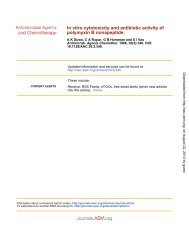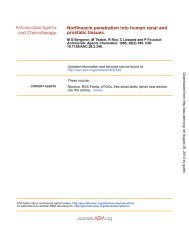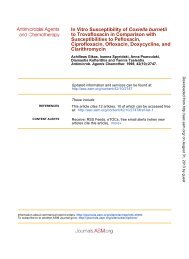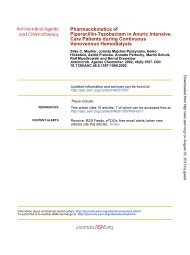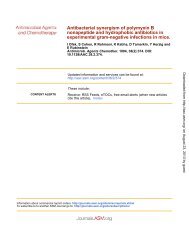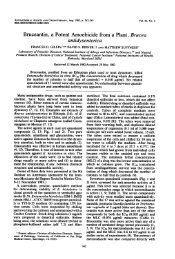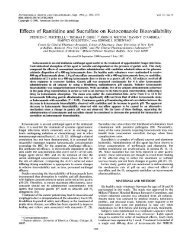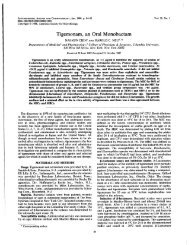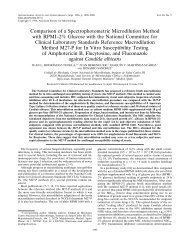Experimental Trichinosis - Antimicrobial Agents and Chemotherapy ...
Experimental Trichinosis - Antimicrobial Agents and Chemotherapy ...
Experimental Trichinosis - Antimicrobial Agents and Chemotherapy ...
Create successful ePaper yourself
Turn your PDF publications into a flip-book with our unique Google optimized e-Paper software.
Comparative efficacy of ketoconazole <strong>and</strong><br />
mebendazole in experimental trichinosis.<br />
J A Hess, P H Ch<strong>and</strong>rasekar, M Mortiere <strong>and</strong> J A Molinari<br />
Antimicrob. <strong>Agents</strong> Chemother. 1986, 30(6):953. DOI:<br />
10.1128/AAC.30.6.953.<br />
CONTENT ALERTS<br />
Updated information <strong>and</strong> services can be found at:<br />
http://aac.asm.org/content/30/6/953<br />
These include:<br />
Receive: RSS Feeds, eTOCs, free email alerts (when new articles<br />
cite this article), more»<br />
Downloaded from http://aac.asm.org/<br />
on August 30, 2013 by guest<br />
Information about commercial reprint orders: http://journals.asm.org/site/misc/reprints.xhtml<br />
To subscribe to to another ASM Journal go to: http://journals.asm.org/site/subscriptions/
ANTIMICROBIAL AGENTS AND CHEMOTHERAPY, Dec. 1986, p. 953-954 Vol. 30, No. 6<br />
0066-4804/86/120953-02$02.00/0<br />
Copyright © 1986, American Society for Microbiology<br />
Comparative Efficacy of Ketoconazole <strong>and</strong> Mebendazole in<br />
<strong>Experimental</strong> <strong>Trichinosis</strong><br />
JOHN A. HESS,1* PRANATHARTHI H. CHANDRASEKAR,2 MARK MORTIERE,3 AND JOHN A. MOLINARI3<br />
Departments of Anatomy1 <strong>and</strong> Microbiology <strong>and</strong> Biochemistry,3 School of Dentistry, University of Detroit, Detroit,<br />
Michigan 48207, <strong>and</strong> Department of Internal Medicine, Division of Infectious Diseases, Wayne State University<br />
School of Medicine, Detroit Receiving Hospital, Detroit, Michigan 482012<br />
Received 23 December 1985/Accepted 15 September 1986<br />
The therapeutic efficacy of ketoconazole <strong>and</strong> mebendazole was studied in ICR/CD-1 mice infected with<br />
Trichinella spiraUs for 17 to 20 weeks. Efficacy of both drugs was over 70% when compared with results in<br />
control mice. This study indicates that both ketoconazole <strong>and</strong> mebendazole should be considered in the<br />
treatment of trichinosis in humans.<br />
The benzimidazoles are considered the agents of choice in<br />
treating the muscle phase of trichinosis (2). Although<br />
thiabendazole has been in use for several years, it has now<br />
been 'replaced by the more effective drug mebendazole<br />
(methyl 5-benzoyl-2-benzimidazole carbamate (12). Several<br />
recent reports documented the efficacy offrmebendazole in<br />
experimental <strong>and</strong> h4man trichinosis (3, 9, 11, 14). However,<br />
the effectiveniess of drug therapy during the late muscle<br />
stages (several months after ingestion of the parasite) of<br />
trichinosis has not been adequately examined. Successful<br />
treatment with prolonged, high-dose mebendazole in chronic<br />
human trichinosis has been reported in one instance (7).<br />
The present preliminary investigation concerned the therapeutic<br />
activity of mebendazole in experimental trichinosis<br />
during the fully encysted chronic phase <strong>and</strong> compared its<br />
anthelminthic activity with that of another imidazole, ketoconazole.<br />
Ketoconazole is a well-known antifungal agent;<br />
however, its anthelminthic activity has heretofore not been<br />
investigated.<br />
The ICR/CD-l mice were 8 to 10 weeks old <strong>and</strong> weighed<br />
30 to 33 g at the time of exposure to infection. The<br />
Trichinella.spiralis larvae were harvested, <strong>and</strong> the animals<br />
were infected with a modification of the' pepsin-hydrochloric<br />
acid digestion method described by Larsh <strong>and</strong> Kent (6>.<br />
Mice harboring the infection for 17 to 20 weeks were<br />
r<strong>and</strong>omly divided into three groups, with one group receiving<br />
ketoconazole, another receiving mebendazole, <strong>and</strong> the<br />
third serving as the control group. Each drug was given<br />
orally in three regimens (Table 1). Suspensions of commercial<br />
formulations of ketoconazole (200 mg of ketoconazole<br />
per Nizoral tablet [Janssens Pharmaceutica, Beerse, Belgium])<br />
<strong>and</strong> mebendazole (100 mg of mebendazole per<br />
Vermox tablet [Janssens]) were used for inoculation. Each<br />
animal received the specified dose of 0.1 ml/10 g of body<br />
weight (Table 1).<br />
Necropsy of mice was carried out 4 days after completion<br />
of therapy. T. spiralis infection was established by exarnination<br />
of the diaphragm from' each animal prior to nematode<br />
isolation'. The 'number of laryae present was estimated by<br />
sampling <strong>and</strong> adjusted With distilled water to the appropriate<br />
dilution. Larval counts from each group of infected mice<br />
(each mouse weighed approximately 35 g) were pooled <strong>and</strong><br />
reported in Table 1 as the total worm burden per group.<br />
* Corresponding author.<br />
During the larval count, the size, appearance (coiled or<br />
uncoiled), <strong>and</strong> motility of the larvae also were recorded.<br />
Tissue samples from the diaphragm <strong>and</strong> psoas muscles<br />
were fixed in 10% neutral buffered Formalin, embedded in<br />
paraffin, <strong>and</strong> cut in 6-ixm sections. These sections were<br />
stain'ed with Harris hematoxylin <strong>and</strong> eosin.<br />
Table 1 shows the relative efficacies of different regimens<br />
of mebendazole <strong>and</strong> ketoconazole for mice with chronic<br />
trichinQsis. The number of larvae in the groups of mice<br />
treated with either drug was considerably less than that<br />
noted in control mice. Marked reduction in the mean worm<br />
burden was noted in group 1' mice treated with 12.5 mg of<br />
mebendazole or ketoconazole per kg pf body weight twice<br />
daily for 4 days. A similar reduction in the worm burden was<br />
noted when the same dose of either drug was given only once<br />
orally (group 2) but for a longer period (8 days). With a larger<br />
dose (group 3; 25 mg/kg), reduction in wortn burden was<br />
slightly less than that seen in groups 1 <strong>and</strong> 2 but not<br />
significantly different.<br />
The microscopic appearance of the diaphragms taken from<br />
the infected control animals showed that the larvae were<br />
normal in size <strong>and</strong> were tightly coiled in well-developed<br />
cysts between the muscle fibers. The capsules were surrounded<br />
by a mild inflammation consisting mainly of lymphocytes,<br />
mononucle'ar phagocytes, <strong>and</strong> foreign-body giant<br />
953<br />
cells.<br />
Most of the larvae from the drug-treated mice were<br />
less than normal in size, loosely coiled or arclike, <strong>and</strong><br />
motionless. However, the viability of larvae from either<br />
control or drug-treated mice was not determined. In the<br />
infected ketoconazole-treated mice, the inflammatory reaction<br />
appeared moderate, whereas in the infected<br />
mebendazole-treated mice, the reaction was considered intense<br />
when compared with the reaction in control mice.<br />
Histolpgically, there did not Iappear to be any differences<br />
between those mice receiving 12.5 mg a:nd those receiving 25<br />
mg of the same drug per kg.<br />
MWbendazole is considered the most effective anthelminthic<br />
agent for the muscle phase of trichinosis. Mebendazole<br />
given at a dose of 12.5 mg/kg of body weight twice daily for<br />
3 days significantly reduced the number of encysted larvae in<br />
mice after 28 days of infection (9). Our study showed similar<br />
efficacy with the same dose of mebendazole given twice<br />
daily for 4 days in mice after several months of infection.<br />
Drug efficacy was not diminished by an 8-day regimen of<br />
mebendazole given once daily (group 2). Although the dose<br />
employed in the study is higher than the recommended dose<br />
Downloaded from http://aac.asm.org/ on August 30, 2013 by guest
954 NOTES<br />
ANTIMICROB. AGENTS CHEMOTHER.<br />
TABLE 1.<br />
Number of T. spiralis larvae recovered from the musculature of control mice <strong>and</strong> mice treated with various regimens of<br />
mebendazole or ketoconazole<br />
Lru os m/k?tength<br />
ofays) No. of mice Mean no. of worms (% efficacy)a/group treated with:<br />
therapy (days)<br />
Control Mebendazole Ketoconazole<br />
1 12.5, Twice daily 4 4 8,166 1,000 (87.7) 981 (88.0)<br />
2 12.5, Once daily 8 6 13,150 1,533 (88.3) 2,283 (82.6)<br />
3 25, Once daily 8 6 9,666 2,700 (72.1) 2,417 (75.0)<br />
a<br />
% Efficacy = [(number of larvae in control group - number of larvae in treated group)/number of larvae in control group] x 100.<br />
of 5 mg/kg for trichinosis in humans (12), a case report of a<br />
patient receiving 22 mg of mebendazole per kg for extended<br />
treatment periods has shown that the drug was tolerated with<br />
minimal side effects (7).<br />
Ketoconazole has been used extensively in humans as an<br />
oral broad-spectrum antifungal agent (10). In addition, it has<br />
been shown to possess activity against many protozoa, as<br />
noted by its antimalarial activity in vitro (13) <strong>and</strong> antileishmanial<br />
<strong>and</strong> antitrypanosomal activity both in vitro <strong>and</strong> in<br />
vivo (1, 8, 15). In the present investigation, 12.5 mg of<br />
getoconazole per kg given pnce or twice daily was shown to<br />
be as effective as mpbendazole in chronic trichinosis. The<br />
slight decrease in efficacy of the high-dose regimen may be<br />
related to host toxicity to higher levels of imidazoles.<br />
Mebendazole is thought to act on the polymerization of<br />
tubulin <strong>and</strong> to block microtubule assembly in helminths (4).<br />
Ketoconazole may have a similar binding affinity with larval<br />
tubulin. Both mebendazole <strong>and</strong> ketoconazole may bind<br />
sterols of helminths as ketoconazole binds the sterols of<br />
fungi, thereby interfering with the formation of cell membrane<br />
(5). Thus, both drugs may exert their effect on<br />
helminths by twp mechanisms. The advantages of ketoponazole<br />
incl4de ease of administration, broad range of activity,<br />
<strong>and</strong> patient tolerance. It should be considered for use in the<br />
treatment of trichinosis.<br />
LITERATURE CITED<br />
1. Berman, J. D. 1981. Activity of imidazoles against Leishmania<br />
tropica in human macrophage c4ltures. Am. J. Trop. Med. Hyg.<br />
30:566-569.<br />
2. Campbell, W. C., <strong>and</strong> D. A. Denham. 1983. <strong>Chemotherapy</strong>, p.<br />
335-366. In W. C. Campbell (ed.), Trichinella <strong>and</strong> trichinosis.<br />
Plenum Publishing Corp., New York.<br />
3. Fern<strong>and</strong>o, S. S. E., <strong>and</strong> D. A. Denham. 1976. The effects of<br />
mebendazole <strong>and</strong> fenbendazole on Trichinella spiralis in mice.<br />
J. Parasitol. 62:874-876.<br />
4. Friedman, P. A., <strong>and</strong> E. G. Platzer. 1980. Interaction of<br />
anthelminthic benzimidazoles with Ascaris suum embryonic<br />
tubulin. Biochem. Biophys. Acta 630:271-278.<br />
5. Halevy, S., <strong>and</strong> L. Avivi. 1966. Sterols of Trypanosomidae. Ann.<br />
Trop. Med. Parasitol. 60:439-444.<br />
6. Larsh, J. E., <strong>and</strong> D. E. Kent. 1949. The effect of ethanol on<br />
acquire.d immunity to infection with Trichinella spiralis. J.<br />
Parasitol. 35:45-53.<br />
7. Levin, M. L. 1983. Treatment of trichinosis with mebendazole.<br />
Am. J. Trop. Med. Hyg. 32:980-983.<br />
8. McCabe, R. E., F. G. Araujo, <strong>and</strong> J. S. Remington. 1983. Ketoconazole<br />
protects against infection with Trypanosoma cruzi in<br />
a murine model. Am. J. Trop. Med. Hyg. 32:960-962.<br />
9 McCracken, R. O., <strong>and</strong> D. D. Taylor. 1980. Mebendazole therapy<br />
of parenteral trichinosis. Science 207:1220-1222.<br />
1Q. Negroni, R., A. M. Robles, A. Arechavala, M. A. Tuculet, <strong>and</strong> R.<br />
Galimberti. 1980. Ketoconazole in the treatment of paracoccidioidomycosis<br />
<strong>and</strong> histoplasmosis. Rev. Infect. Dis. 2:643-<br />
649.<br />
11. Ozeretskovsaya, N. N., T. M. Morentets, E. V. Pereverezeva,<br />
A. M. Bronstein, N. L. Veretennikova, M. 0. Kolosova, A. M.<br />
Poverenny, V. K. Podgorod-Nichenko, <strong>and</strong> D. A. Kagorodin.<br />
1981. Therapeutic properties of benzimidazoles in trichinellosis<br />
<strong>and</strong> the side effects of the treatment, p. 287-290. In C. W. Kim,<br />
E. J. Ruitenberg, <strong>and</strong> J. S. Teppema (ed.), Trichinellosis.<br />
Reedbooks, Chertsey, Engl<strong>and</strong>.<br />
12. Pawlowski, Z. S. 1981. Trichinellosis, p. 84. In H. F. Conn<br />
(ed.), Current therapy. The W. B. Saunders Co., Philadelphia.<br />
13. Pfaller, M. A., <strong>and</strong> D. J. Krogstad. 1981. Imidazole <strong>and</strong> polyene<br />
activity against chloroquine-resistant Plasmodium falciparum.<br />
J. Infect. Dis. 144:372-375.<br />
14. Sonqet, J. J., <strong>and</strong> D. Thienpont. 1977. The treatment of<br />
trichinosis with mebendazole. Acta Clin. Belg. 32:297-302.<br />
15. Urcyo, F. G., <strong>and</strong> N. Zaias. 1982. Oral ketocopazole in the<br />
treatment of leishmaniasis. Int. J. Dermatol. 21:414-416.<br />
Downloaded from http://aac.asm.org/ on August 30, 2013 by guest




